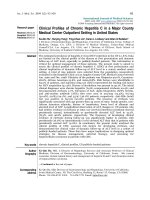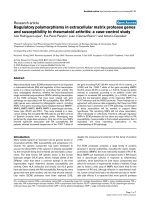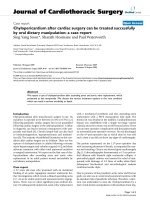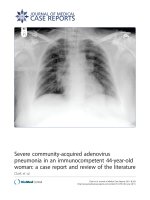Báo cáo y học: " Carcinoid tumor of the verumontanum (colliculus seminalis) of the prostatic urethra with a coexisting prostatic adenocarcinoma: a case report" docx
Bạn đang xem bản rút gọn của tài liệu. Xem và tải ngay bản đầy đủ của tài liệu tại đây (3.66 MB, 4 trang )
CAS E REP O R T Open Access
Carcinoid tumor of the verumontanum
(colliculus seminalis) of the prostatic urethra
with a coexisting prostatic adenocarcinoma:
a case report
Maxwell Smith, M Scott Lucia, Priya N Werahera , Francisco G La Rosa
*
Abstract
Introduction: Urethral carcinoid tumors are very rare tumors with only four cases described in the literature.
Case presentation: We present the case of a 61-year-old man with a prim ary carcinoid tumor of the
verumontanum (colliculis seminalis) portion of the prostatic urethra with a coexisting prostatic adenocarcinoma. In
addition to whole mount hematoxylin and eosin staining, special immunoperoxidase staining specific for
chromogranin A, neuron specific enolase, synaptophysin, pan-cytokeratin and PSA, and a special combined staining
for racemase (a-methyl CoA) antigen and p63 antigen were performed. A review of the literature is included.
A single focus of invasive prostatic adenocarcinoma was identified in the periphery of the mid-left, posterior quad-
rant of the prostate. Approximately 17 mm from this adenocarcinoma, within the verumontanum of the prostatic
urethra, there was a 3 mm maximal dimension carcinoid tumor.
Conclusion: Based on different histological features and antigenic profiles, we concluded that the two tumors
were distinct.
Introduction
Carcinoid tumors of the urethra are exceedingly rare
neoplasms, with only four cases reported in the litera-
ture [1-4]. Given this small number, their clinical pre-
sentation, course and prognosis are difficult to elucidate.
We report the first case of a primary carcinoid tumor
within the verumontanum of the prostatic urethra in a
61 year-old man who underwent radical prostatectomy
for adenocarcinoma of the prostate. We reviewed the lit-
erature for both primary carcinoid tumors of the urethra
and for synchronous urethral carcinoid tumors and pro-
static adenocarcinoma.
Case presentation
Our patient is a 61-year-old Caucasian man who origin-
ally presented with urinary ob structive symptoms and a
serum prostate specific antigen (PSA) level of 1.5 ng/mL
six years before prostatectomy. The obstructive process
was treated conservatively, with observation and symp-
tomatics. Over the following three years, PSA of our
patient continued to rise, prompting multiple sets of
prostaticbiopsiesthatwerenegativeforcarcinoma.
Ultrasound showed a moderately enlarged nodular pro s-
tate consistent with benign prostatic hyperplasia. A few
weeks before prostatectomy, his serum PSA increased
up to 4.7 ng/mL, at which time additional core biopsies
were performed. A single focus of Gleason grade 3+3
(score = 6) prostatic adenocarcinoma was identified,
involving5%ofonlyoneofthetissuecoressubmitted.
Our patient was subject to undergo a radical prostatect-
omy. A conventional suprapubic, radical prostatectomy
on our patient was performed. The prostate was sub-
mitted for whole-mount processing. Gross examination
revealed a 32 gm prostate measuring 4.2 cm apex-base,
4 cm wide, and 3.5 cm antero-posterior. The attached
seminal vesicles were up to 2.4 cm in length and 0.4 cm
average diameter. Also submitted were dissections of
the right and left pelvic lymph nodes. The prostate was
* Correspondence:
University of Colorado Denver, Department of Pathology, Aurora, Colorado
80045-0508, USA
Smith et al. Journal of Medical Case Reports 2010, 4:16
/>JOURNAL OF MEDICAL
CASE REPORTS
© 2010 Smith et al; licensee BioMed Central Ltd. This is an Open Access article distributed under the terms of the Creative Commons
Attribution License ( which permits unrestricted use, distributio n, and reproduction in
any medium, provided the original work is properly cited.
fixed in formalin, serially sectioned i n 5 mm intervals
from apex to the base and paraffin embedded. Histologi-
cal sections, 5 μm-thick, were cut from the anterior face
of each paraffin block, mounted on 2 × 3-inch glass
slides and stained with conventional hematoxylin and
eosin. Immunoperoxidase staining specific for chromo-
granin A, neuron specific enolase, synaptophysin, pan-
cytokeratin and PSA, and a special combined staining
for racemase [a-methyl CoA] antigen and p63 antigen
were performed.
Digital microscopic pictures were obtained during dif-
ferent magnifications using an Olympus BX51 micro-
scope (Oly mpus, Japan) and a Macrofire digital camera
(Optronics, Goleta, CA) connected though a firewire to
a Dell Optiplex 745 desktop computer (Dell, USA). Low
power images from whole mount slides were digitally
scanned using an Aperio ScanScope Model T3 (Aperio
Technologi es, Inc., Vista, CA, USA) and captured using
the ImageScope software version 9.x (Aperio Technolo-
gies, Inc., Vista, CA, USA). All images were optimized
using Adobe Photoshop CS2 software (San Diego, CA).
A single focus of invasive, variably spaced, small atypi-
cal acinar glands without basal cells was identified in the
periphery of the mid-left, posterior quadrant of the pros-
tate, involving less than 5% of the prostati c tissue (Figure
1). The cytologic features were consistent with prostatic
adenocarcinoma and in cluded enlarged and overlapping
nuclei wit h prominent and peripherall y marginated
nucleoli (Figures 2Band 2C). The tumor from our patient
was organ confined, without angiolymphatic, perineural,
extracapsular or seminal vesicle invasion, and with nega-
tive surgical margins. Additional histopathology included
focal high grade prostatic intraepithelial neoplasia, benign
prostatic hyperplasia, focal acute and chronic
Figure 1 Location of (A) the carcinoid tumor in the verumontanum of the prostatic urethra; and ( B) the prostatic adenocarcinoma
within the prostate at the right posterior lobe of the prostate. These consecutive whole prostatectomy slices were sectioned 5 mm apart
and the tumors appear to be located at approximately 17 mm from each other. Hematoxylin-eosin staining (scanned slides with Aperio system).
Smith et al. Journal of Medical Case Reports 2010, 4:16
/>Page 2 of 4
inflammation, focal glandular atrophy and basal cell
hyperplasia. The two right and two left pelvic lymph
nodes were without evidence of malignancy.
Approximately 17 mm from t he invasive adenocarci-
noma, within the verumontanum of the prostatic urethra
of our patient, there was a 3 mm maxi mal dimension
tumor with markedly different morphology. From low
microscopic power, the tumor of our patient appeared
well circumscribed with pushing, rather than invasive,
margins (Figure 3). Higher power examination revealed
cells forming n ested, acinar and trabecular archite cture
with small uniform nuclei, a granular “salt and pepper”
chromatin pattern, and moderate amounts of granular
cytoplasm (Figure 2A). Mitotic figures, necrosi s, and
angiolymphatic invasion were not identified. Immuno-
peroxidase staining for chro mogranin A, neuron specific
enolase, and synaptophysin were positive in nearly 100%
of the urethral tumor cells, showing a granular cytop las-
mic distribution (Figure 4). These cells were negative for
pan-cytokeratin and PSA. Immunoperoxidase staining
for PSA was positive in the prostatic adenocarcinoma
cells, which also were positive for racemase (a-methyl
CoA) antigen and negat ive for p63 antigen. Based on this
pattern of reactivity, we concluded that the two tumors
were distinct and a diagnosis of carcinoid tumor was
made on the urethral tumor of our patient. An electron
microscopy was attempted on our patient for neurosecre-
tory granules in the urethral tumor, but it was unsuccess-
ful due to formalin fixation artifact.
Discussion
Carcinoid tumors of the urethra are exceedingly rare
neoplasms. Using Pubmed and the search words “ ure-
thra” and “carcinoid” only four articles are found, each
reporting a single additional case of a urethral carcinoid
tumor [1-4]. The first case of urethral carcinoid,
reported by Sylora et al. in 1975, involved an 8 mm
lesion of the penile urethra in a 47-year-old man.
Including our case, urethral carcinoid tumors primarily
appear on men (men:women 4:1), with an average age
of 47 years (range 39-60 years), a nd an average size of
5.6 mm (range 3-8 mm). Urethral carcinoids appear to
be more common in the penile urethra with three of the
four male cases occurring in that location. The case in
the woman occurred at the urethral orifice. All cases,
including our case, showed a similar histology character-
ized by sheets, acini, trabeculae, and nests of small uni-
form cells with a coarse nuclear chromatin pattern.
Neuroendocrine differentiation of the tumor cells was
confirmed in each instance by immunohistochemical
Figure 2 (A) Carcinoid tumor (40× objective), (B) and C) prostatic adenocarcinoma Gleason grade 3 + 3 (sum = 6) (10× & 40×
objectives). Hematoxylin-eosin staining.
Figure 3 Carcinoid tumor of the v eramontanum (colliculus
seminalis) of the prostatic urethra, hematoxylin-eosin staining
(2× objective).
Smith et al. Journal of Medical Case Reports 2010, 4:16
/>Page 3 of 4
analysis for neuron-specific enolase, chromogranin A,
and/or synaptophysin a nd/or electron microscopy stu-
dies showing neurosecretory granules.
While concurrent prostatic adenocarcinoma and ure-
thral c arcinoid tumor have yet to be reported, concur-
rent prostatic adenocarcinoma and prostatic carcinoid
tumors are rarely reported [5,6]. Because prostatic ade-
nocarcinoma may undergo neuroendocrine differentia-
tion, with prognostic and treatment implications, its
distinction from primary carcinoid is imperative. A com-
bination of histologic, immunohistochemical, and geo-
graphical differences between the two tumors in
question, as seen in our present case, are used to make
the diagnosis. Immunological markers to identify a pro-
static gland origin of the tumor included PSA, combined
racemase (a-methyl CoA) and p63 antigen and pan-
cytokeratin. Markers to identify the neuro-endocrine
origin of the second tumor include chromogranin,
synaptophysin and neurone specific enolase.
Conclusion
Ourcaseisuniqueinmanyways.Itisthefirstcaseofa
patient with a primary carcinoid tumor in the prostatic
urethra, and more specifically within the verumontanum.
Secondly, it represents the oldest patient reported with a
urethral carcinoid (61 years old). It also represents the
first case of a concurrent urethral carcinoid with a pri-
mary adenocarcinoma of the prostate.
Consent
Written informed consent was obtained from our
patient for publication of this case report and accompa-
nying images. A copy of the written consent is available
for review by the Editor-in-Chief of this journal.
Abbreviations
PSA: Prostate specific antigen.
Acknowledgements
The authors acknowledge the valuable contribution of our technical
personnel in the Prostate Diagnostic Laboratory, University of Colorado
Denver: Erin Genova, Kathy Lux, Margaret Clark, John Twitchell, Nancy
Duscom, Andrea Albeyta, Robert Dayton and Storey Wilson.
Authors’ contributions
MS was the major contributor in writing the manuscript. MSL and PNW
reviewed and discussed the manuscript. FGLR performed the original
histological examination of the prostate, interpreted and diagnosed the
pathology findings, prepared the figures and did the literature review. All
authors read and approved the final manuscript.
Competing interests
The authors declare that they have no competing interests.
Received: 19 September 2009
Accepted: 20 January 2010 Published: 20 January 2010
References
1. Murali R, Kneale K, Lalak N, Delprado W: Carcinoid tumors of the urinary
tract and prostate. Arch Pathol Lab Med 2006, 130(11):1693-1706.
2. Katayama M, Hara A, Hirose Y, Yamada Y, Kuno T, Sakata K, Morioka T,
Inamine M, Shibuya C, Mori H, Yoshimi N: Carcinoid tumor in the female
urethral orifice: rare case report and a review of the literature. Pathol Int
2003, 53(2):102-105.
3. Chen KT: Primary carcinoid tumor of the urethra. J Urol 2001,
166(5):1831-1832.
4. Sylora HO, Diamond HM, Kaufman M, Straus F, Lyon ES: Primary carcinoid
tumor of the urethra. J Urol 1975, 114(1):150-153.
5. Wasserstein PW, Goldman RL: Primary carcinoid of prostate. Urology 1979,
13(3):318-320.
6. Ghannoum JE, DeLellis RA, Shin SJ: Primary carcinoid tumor of the
prostate with concurrent adenocarcinoma: a case report. Int J Surg Pathol
2004, 12(2):167-170.
doi:10.1186/1752-1947-4-16
Cite this article as: Smith et al.: Carcinoid tumor of the verumontanum
(colliculus seminalis) of the prostatic urethra
with a coexisting prostatic adenocarcinoma:
a case report. Journal of Medical Case Reports 2010 4:16.
Figure 4 Immunoperoxidase staining for chromogranin A (20×) (A), neuron specific enolase (B) and synaptophysin (C) of the carcinoid
tumor cells (40× objective).
Smith et al. Journal of Medical Case Reports 2010, 4:16
/>Page 4 of 4









